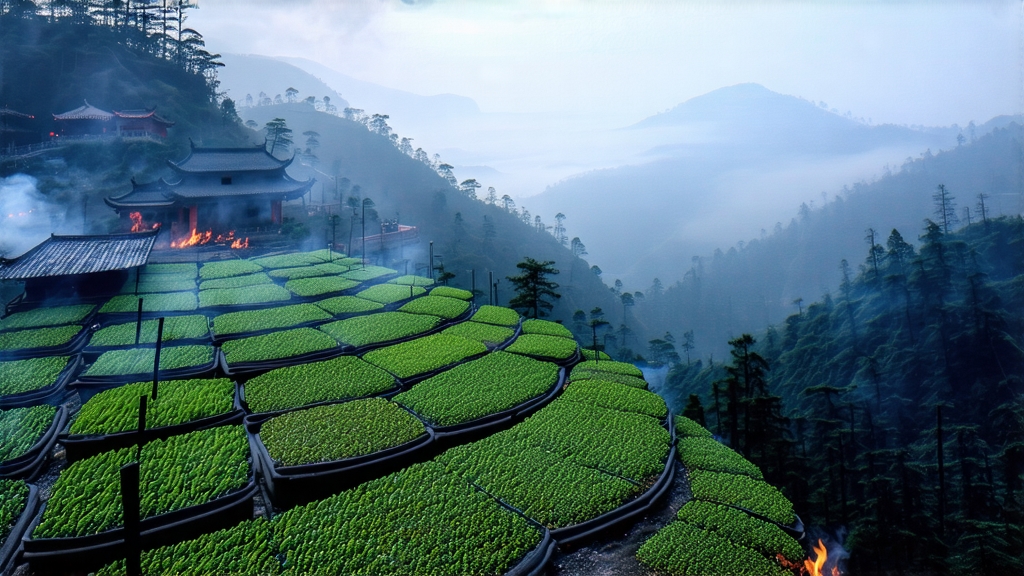
If you ask Chinese tea historians to name the first black tea ever created, they will point north-westward to the rugged Wuyi Mountains of Fujian Province and utter two syllables that have echoed across four centuries: Zheng Shan Xiao Zhong, known in the West as Lapsang Souchong. Revered as the progenitor of every subsequent black tea, this leaf carries within its twisted, tar-black strands the dual signature of Chinese ingenuity and terroir: a sweet, longan-like maltiness wrapped in an unmistakable whisper of pine smoke. For international drinkers accustomed to the bright malt of Assam or the winey perfume of Ceylon, Lapsang Souchong offers a journey backward in time—to the moment when tea left the green realm and stepped into the dark, propelled by accident, war, and the scent of resinous wood.
Historical records place the birth of Lapsang Souchong around 1568, late in the Ming Dynasty. Local legend claims that a passing army requisitioned the drying sheds of Tongmu village, forcing tea farmers to hastily finish their freshly picked leaves over open pine fires so that the crop could be rushed to market before the soldiers returned. The improbable result was a tea whose coppery liquor tasted of caramelized sugar and campfire, a flavor so novel that it captivated the Dutch traders who first carried it to Europe in 1604. By the early Qing period, “Bohea” (a corruption of “Wuyi”) had become a fashionable term in London coffeehouses, and Lapsang Souchong—picked from the original protected micro-valleys of Tongmu and Guadun—commanded prices higher than silver. The East India Company’s obsession with replicating the tea outside China ultimately led to the industrial espionage of Robert Fortune in 1848, an episode that spread black-tea horticulture from Assam to Sri Lanka and Africa, making Lapsang Souchong the spiritual ancestor of a global commodity now worth billions.
Strictly speaking, only leaf harvested within the 600–1,200 m core zone of the Wuyi National Nature Reserve may be called Zheng Shan (“Original Mountain”) Xiao Zhong. Here, a subtropical monsoon climate shrouds tea gardens in fog for two hundred days a year, slowing photosynthesis and concentrating amino acids that later translate into sweetness. The indigenous cultivar is a small-leaf Camellia sinensis var. sinensis locally nicknamed “cai cha,” prized for its low tannin and high fragrance. Two distinct styles are produced today. The traditional, smoke-dried version, exported since the seventeenth century, acquires its character from the final stage of processing when the leaves are spread on bamboo trays suspended over smoldering pinus massoniana logs inside a three-story wooden loft called a qing lou. The modern “unsmoked” or “craft” style, developed for the domestic Chinese market in 2005, omits the pine phase, allowing the natural honey, longan and lychee notes to dominate; it is sometimes marketed as Zheng Shan Xiao Zhong “Original Sweet” to distinguish it from its assertive, campfire-scented sibling.
Plucking begins in late April, when the standard becomes “two leaves and a bud, still folded like a sparrow’s tongue.” The tender shoots are carried in bamboo baskets lined with fresh tea-garden leaves to prevent bruising, then withered over night in the cool mountain air on second-floor bamboo racks. Once the grassiness dissipates and a faint fruit aroma emerges, the leaves are rolled—traditionally by foot in a deep bamboo trough, now more hygienically by machine—breaking cell walls and initiating oxidation. After two hours the leaf edges turn coppery red; the pile is transferred to woven rattan baskets and covered with wet cloths, a short piling that accelerates enzymatic browning without reaching the heavy fermentation of Yunnan Dian Hong. When the mass releases a ripe lychee fragrance, the tea master fires it in an iron wok at 200 °C for less than a minute, a “killing green” step that fixes the aromatic compounds. The crucial divergence occurs next: for smoked Lapsang, the semi-dried leaf is moved to the top floor of the qing lou where pine logs, previously soaked to moderate temperature, release a steady stream of cool smoke for six to eight hours. The tea absorbs only the volatilized resin, not the tar, resulting in a clean, sweet smoke reminiscent of single-malt Islay whisky rather than a